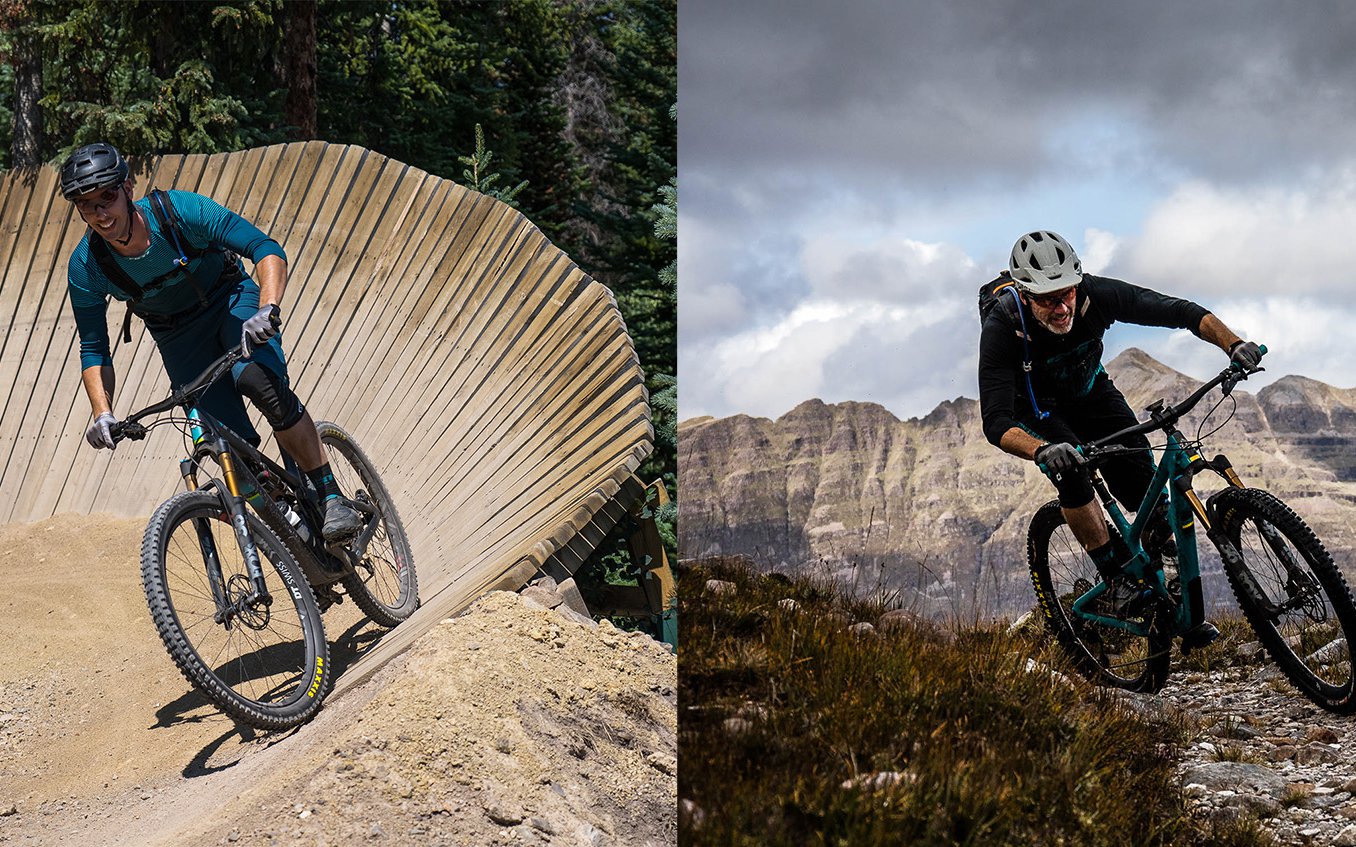
Interview
Yeti Cycles Interview: Chris Conroy and Stretch
Ahead of the release of my long term review of the Yeti SB150, I had a few questions that needed answering. Rather than having a personal chat with someone at Yeti I decided to interview Yeti's Director of Engineering, Peter "Stretch" Zawitowski more publicly. Having Yeti co-founder and President Chris Conroy sit in was an unexpected bonus. Our discussion is long on bike nerdery (and just plain long) but we also talk about some of the perceived issues of the new SB bikes, why it took so long to figure out long-low-slack and about the secret sauce that makes Yeti bikes so good. And it turns out that secret isn't so secret after all (it just might be the people at Yeti).
Read on and learn from the smartest man at Yeti and the godfather of the brand...
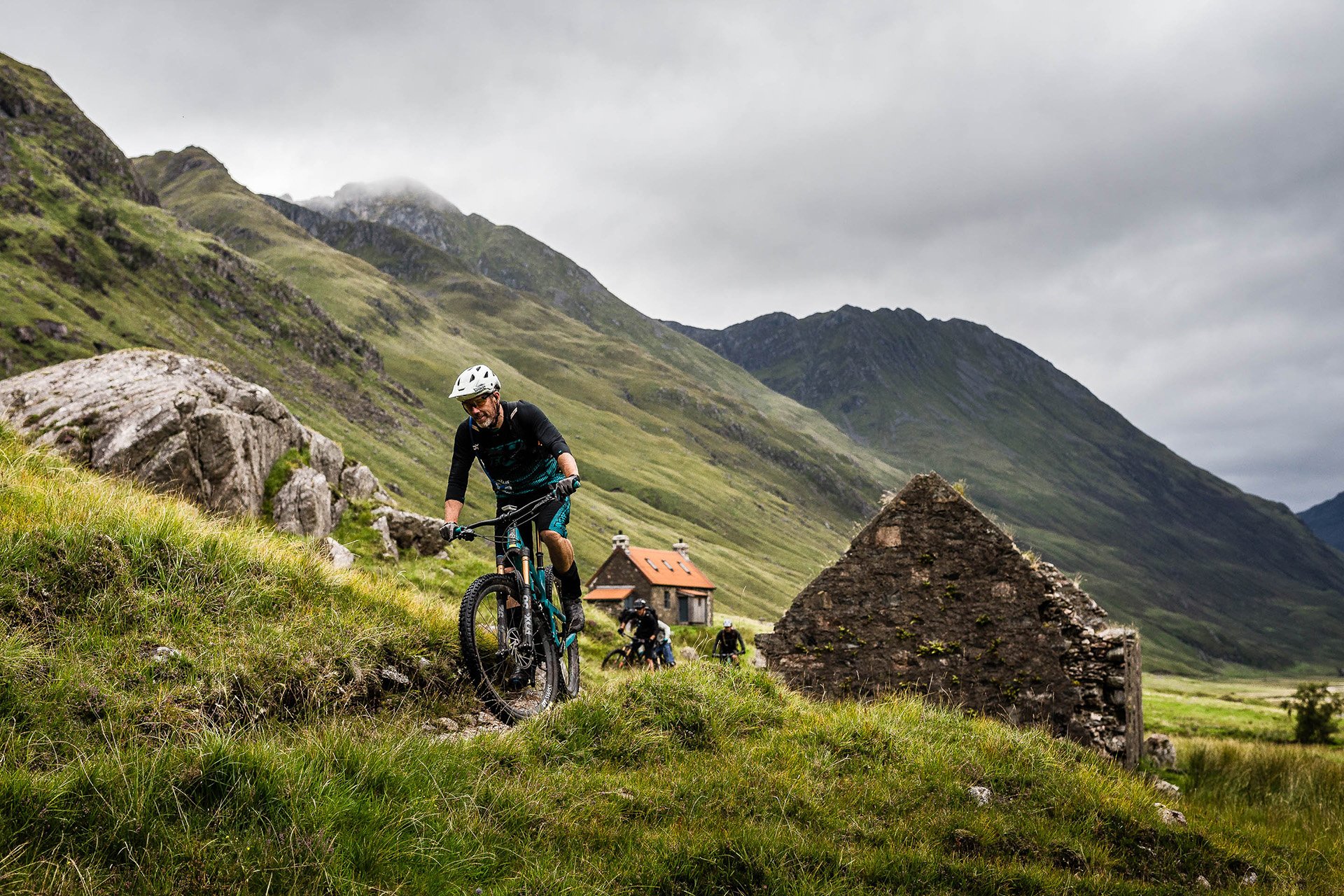
Yeti devotees are known as the Tribe, and devoted they are. Each year Yeti holds 'Tribe Gatherings' in riding destinations, some for Yeti 'Betis' and some for both Betis and Berties. Pictured here is Chris Conroy riding in the Scottish Highlands. Each year for the past four years there have been two Tribe Gatherings, one international and one stateside. Photo - Ross Bell
Cam McRae: And we are recording. Hi Chris. And hi Peter. I don't think we've met.
Peter Zawistowski: Nice to meet you.
Cam McRae: And you as well.
Chris Conroy: A little introduction. Peter's been with us for 15 years. He started as an intern when he was in high school and then went on to study engineering and he's been our engineer for the last 10 years. So he can speak to design iteration and logic as we go through it. I can speak to market reasons we've moved in certain directions and product reasons we moved in certain directions. We figured we’d be good to have the full range of opinions.
Cam McRae: Excellent. Now Peter, the story I heard is that you worked at Yeti and then went to university and got your engineering degree with the idea of coming back and working at Yeti once again. Is that correct?
Peter Zawistowski: Pretty much. I started working at Yeti when I was in school. At that time I was doing pretty much anything in the back. Assembling and shipping out bikes. We were making alloy bikes in house and I was doing post processing on those; machining and reaming BBs. From there I started working at Yeti every summer and anytime I was available after the end of my freshman year. Eventually I started working on some engineering projects and then became a full time engineer.
Cam McRae: That's a great story and it's a nice lesson for... maybe the kids in my house. So the first question is why it seems that the SB100, 150, and 130 are such radical departures from the SB4.5, 5.5 and 6, and how that came to be?
Chris Conroy: I would say over the years our lines progressed. We've never been afraid to make fairly radical changes in our lines. We think that it's substantially better. So that progression has always been part of who we are. We were working with a few different things; we wanted to accommodate a water bottle in the main triangle and that comes with some geometry and packaging requirements so that changes the look and shape of the bike a little bit. We've always been experimenting with kind of that long slack and low thing. But you know, the reality is the short fork offsets and having different offsets available, just changed the game there. I think later on you had some questions specific to you know, why that progression has happened and why people are embracing that just now and it really like a function of the offsets we had available to accommodate that without making the front end feel like it was too floppy on the uphill or, or to plowy so it would only work in very steep terrain. We had also been working with a lot of different kinematics and what we wanted the suspension to do - specifically have a more progressive curve. And as you go through our line the 100 was a little bit more progressive and then the 130 is more progressive than that and then the 150 is more progressive than that. So it just kind of steps up. And I think the numbers are 9% 12 and 15 is that right Peter?
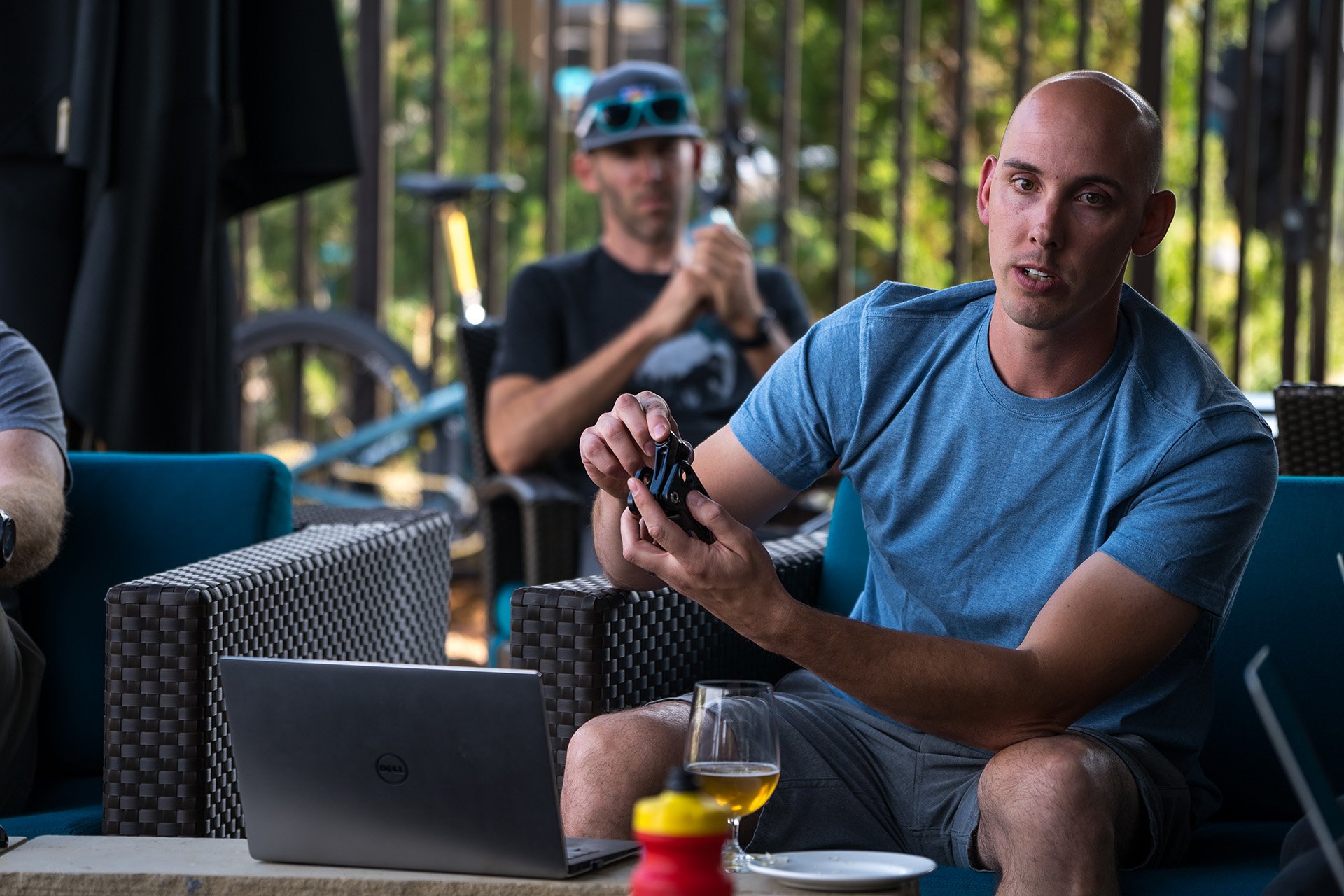
Stretch talks shock extenders while Geoff Kabush looks cool (as usual) in the background.
Peter Zawistowski: 10, 12, and 15. Our first goal was really to explore geometry that was progressive that we've been testing for a while and the other thing we wanted to do was to have a small size frame in a long travel 29er which we didn't have, with the 5.5 but we also wanted a water bottle as Chris mentioned. We wanted to do that while fitting an air shock or a coil shock. We also wanted to lower the standover and retain our pedalling efficiency that we have with switch infinity. And the other thing we wanted to do was modify the leverage ratio. There's a couple of reasons for this, but basically overall the way that shocks are evolving we wanted to have greater compatibility as they are inherently becoming more linear in nature. So we wanted to be able to allow for a more progressive leverage ratio and it also allows for a larger tuning window. for varying rider weight and rider styles. That kind of radical departure in terms of design and what we have going on with the shock extensions, the general layout of the bike, is all a result of that focus of the design.
Cam McRae: Did you do any market research about the impact not having an inside-the-main-triangle water bottle mount costs you in terms of sales, how did you evaluate that?
Chris Conroy: Like anything in the bike business the market feedback is pretty atrocious. It was really friends and editors saying, "hey man, I love this bike, I just want a water bottle in the main frame." That's something that forever we resisted. And there are a few different reasons for that. Frankly, some of it was looks. And ultimately we decided that internally as well we were kind of minimalists when you go out on a ride and want to take one water bottle and not have the Camelbak and so there was a push internally to listen to what the market's saying on that. it's pretty clear and concurrently to the other things we were hearing was; we want a lifetime warranty on the frame. So we said, okay, let's address these two issues in the marketplace. Everybody says, I love this. If it just had, you know, X, Y, Z and a water bottle and lifetime warranty were the two biggest and we have the confidence that we could pull it off from a design perspective and we had confidence in our product to offer the lifetime warranty at the same time.
As a result, internally when we were doing our testing we were putting longer and longer forks on our test bikes and ultimately what we go to market with is what we all rubber stamp here.
Cam McRae: So when you change your warranty, does it change the way you approach the engineering of the bike?
Peter Zawistowski: It does not. We treat it the same way regardless.
Cam McRae: Obviously there are potential headaches further down the road, but you want to try and make your bikes as strong as possible regardless because people are going to have a better experience.
PZ: Exactly.
CM: Do you use aluminum mules for prototyping?
CC: Sometimes we do. Even more so now we have such a strong relationship with our carbon supplier that oftentimes to make sure we can do what we're trying to do, we can get a carbon prototype faster. And and we also can then test it with the right material and start going through the process of starting to nail the layup very early on. In some models we have some aluminum mules for stuff we're working on in the back right now, but those are on a little bit longer time frame. Um, so it just depends on the project. In this case, we started with carbon prototypes.
PZ: Switch Infinity is something we're very confident in theoretically and what's happening from a kinematic standpoint so we're more confident in moving to a carbon prototype quicker. The material also is a factor in how the bike is going to ride and so It just makes more sense to go that direction.
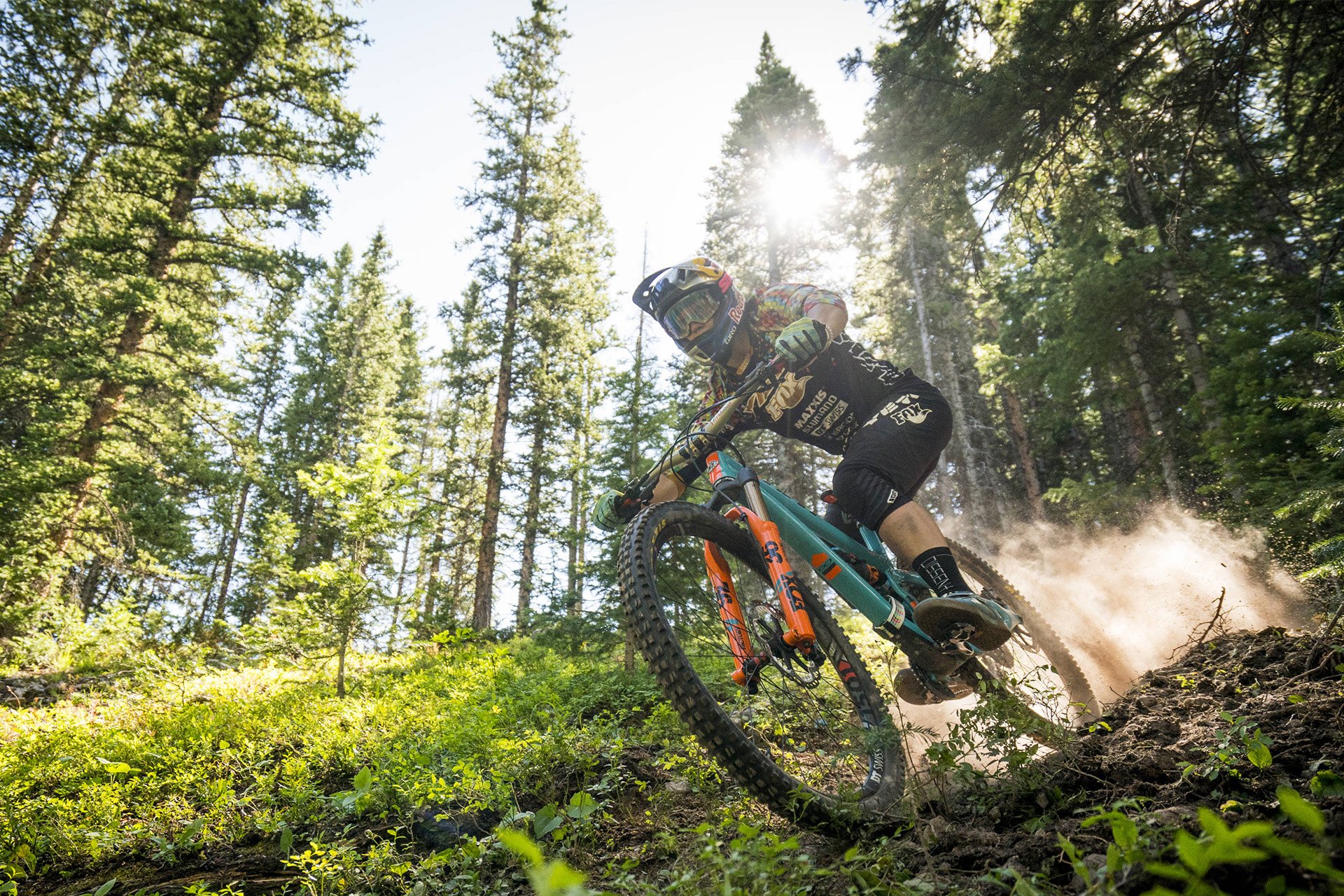
In the 2017 season Richie Rude divided his time between the SB6 and the SB5.5. This year he'll be full time on the SB150, and it seems he'll be rolling the coil.
CM: Looking at the switch infinity used in these bikes and switch infinity used before in the SB5.5 and those bikes, obviously the bikes are more progressive. Is there much change to the switch infinity action?
PZ: THere is very little change there. In general that motion is very consistent across all of our models prior and now and when I say that the general motion of it, upwards and then moving downward, that motion remains on all of our models, but that specific amount of motion and when it happens and where it occurs in the travel is very specific to each model so that it's tuned correctly. I think one of the most common misconceptions with Switch Infinity is that they're like, "oh man, there's only a few millimeters of motion. What could that possibly be doing?" You know, it's not worth it. It's a single pivot and so on. But that small amount of motion is actually a difficult thing to achieve from a linkage standpoint. And the reason we do it is that it has a large effect on the kinematics. So that small amount of motion there and where it's occurring and how it's occurring is really what is achieving the ride of the bike. And if you actually looked at anti-squat curves or any other kinematics variable that we're looking at and you compare that to say a single pivot, when people picture the little bit of motion in that area, it's just dramatic change in those curves and what's happening. I guess one way to look at is depending on the model we have the general trend of what's happening with that mechanism is the same, but it's very individually specifically tuned per model.
CM: And is anti-squat the main consideration?
PZ: I think the two two main considerations and the easiest to discuss are anti-squat and leverage ratio. And those two are very dependent on that mechanism's motion and individually tuned with the Switch Infinity motion.
CM: We talked about this but I want to delve a little more into your perception of the benefits of Switch Infinity versus a dual link system, which obviously have similar goals and go about achieving them in different ways,
PZ: Our suspension is a four bar linkage, it's just a very unique one in that one of the members has linear motion - the Switch Infinity mechanism. The other element that is unique about our is not only does it have this linear motion as part of the four bar system, we also have the reversing or switching of the system. And the linear motion and the switching of that motion allow us to fine tune our anti-squat and leverage ratio very specifically and in a way that's impossible to fine tune to such a degree with other linkage systems. And that's what I would say distinguishes switch infinity from another four bar or another dual link bike - whatever you want to call it. It's tough to describe when you don't have curves in front of you but in general we have a specific anti-squat curve that we are after and the look of that curve is very specific mathematically. We are able to achieve that. Whereas if I wanted to try to achieve the same thing with another dual link system, I could maybe get something generally like what we're after much more broad and not nearly as accurate relative to what we can do with Switch Infinity. It's a broad way to describe it but tough without figures.
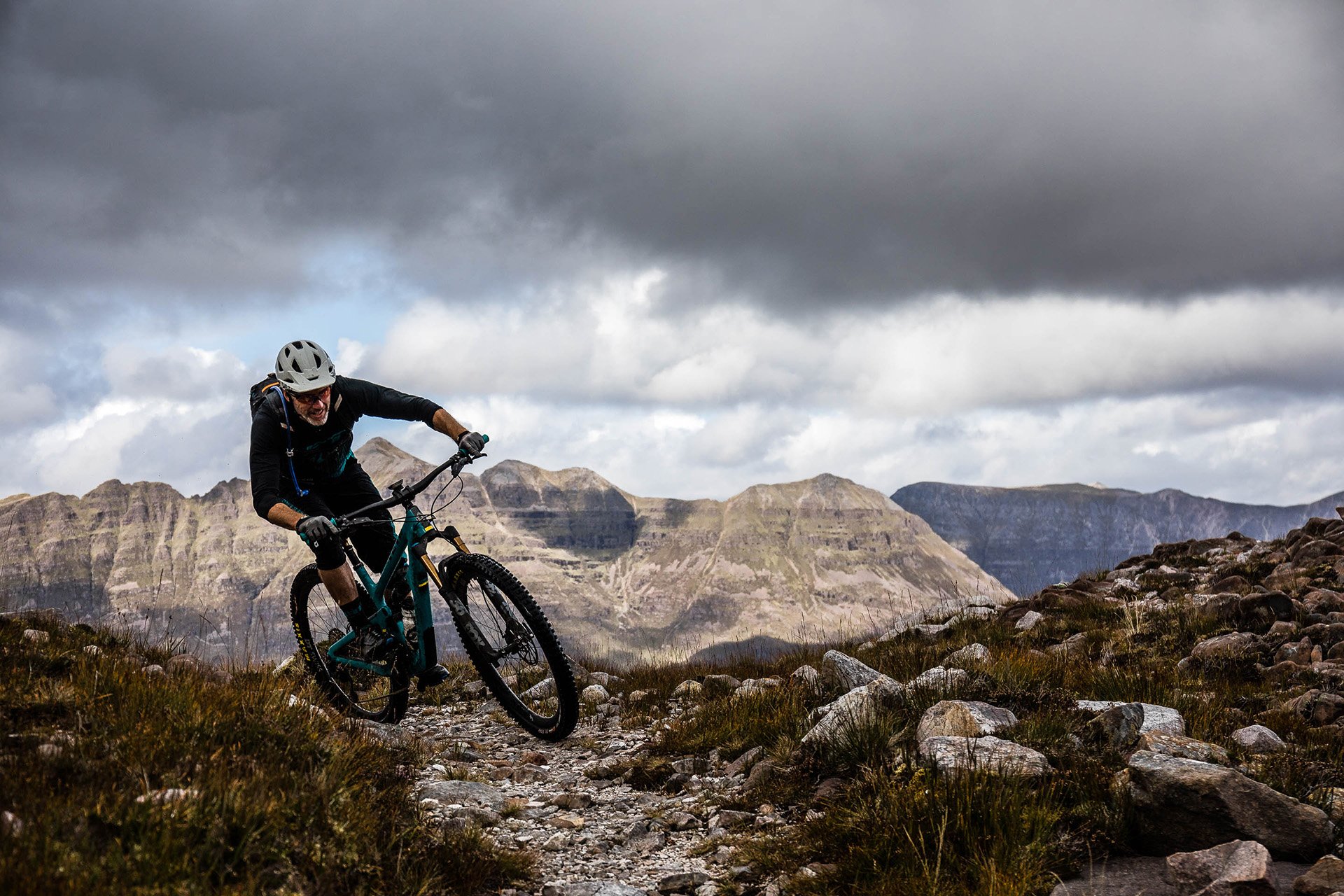
Chris Conroy will tell you that Yeti Tribe Gatherings are all work. Photo - Ross Bell
CM: One of the things I try to do as a tester is to operate as I would if I was Joe consumer - but not a fastidious Joe. So that means not necessarily maintaining the bike as well as it should be. And even not as well as I would if I'd purchased it because that's often the case with consumers. They don't look after things very well and don't pay attention to schedules sometimes. So the linear bearing becomes quite an interesting component to that. One of the things is, yes, I could have easily gone out and found a needle grease gun. But I didn't have one on hand, so instead I wanted to take Switch Infinity apart. I've seen one taken apart. I know what it's like taken apart but I wanted to look at the guidelines as well. So a bit of a departure from Joe consumer because they might not have done that. But then I encountered the warnings suggesting if you take the linear bearing apart you can lose of control of the bicycle resulting in serious injury or death and this kind of stuff.
PZ: Those weren't ours (laughing)
CM: No, I realize that's Fox but I have to wonder where that hyperbole comes from.
CC: I can't speak to why they have that legal speak there. I imagine it's related to being a publicly-traded company with a lot of attorneys. But the Switch Infinity is a pretty simple mechanism. Really it's just two bearings pressed in and then you have some bushings. One consideration is that Switch Infinity is covered under the lifetime warranty. So they could send it back and we can do whatever maintenance is necessary. It's a super tight tolerance system and that helps ensure that it keeps the whole suspension mechanism's stiff and working well and so we just want to make sure that we control that.
CM: Okay. Say they take it apart and clean it and grease it and put it back together, is there a danger if they do that in a methodical fashion and put the correct shafts in the holes they came from?
PZ: There's not a danger there and people do that all the time. What's happening from a legal perspective is out of our hands and we're trying to adhere to what Fox wants us to do. But there is a danger they will not be handled correctly and that's really what we are trying to prevent. But if you're keeping it simple and you're taking it apart to clean it and regreasing it that's the safest way to go about it from a performance standpoint to make sure it's behaving as intended.
CM: So to be clear from a warranty perspective if someone finds wear on one of their shafts they can send you their whole linear bearing? I guess they won't be able to see wear unless they take it apart.
CC: Depending on where they are, if they have an issue they can take it to a shop and we work with the shop to figure out the best solution. It's usually a very quick turnaround. Anybody who is not on their bike, we want to make sure they get on their bike immediately. And it hasn't been an issue. I mean it's, it's a pretty rare thing.
CM: Cool. So then from a shop perspective is a shop able to replace a single shaft or can they only replace full mechanisms as well?
CC: We just have them send us the whole mechanism and we either replace the shaft or we send them a whole new mechanism.
CM: Okay.
CC: And that way we can make sure that everything is built to factory SPEC. And the reality is we probably just replace the mechanism.
CM: So the tolerances are going to be right and it's going to be inspected properly. Okay. The other part of the consumer facing angle is, if you purchase a complete bike, does it come with a needle grease gun?
CC: It does not. We have it available on our website if somebody wants to use the specific grease that we use. But I think it's usually fairly stock in most people's toolkit.
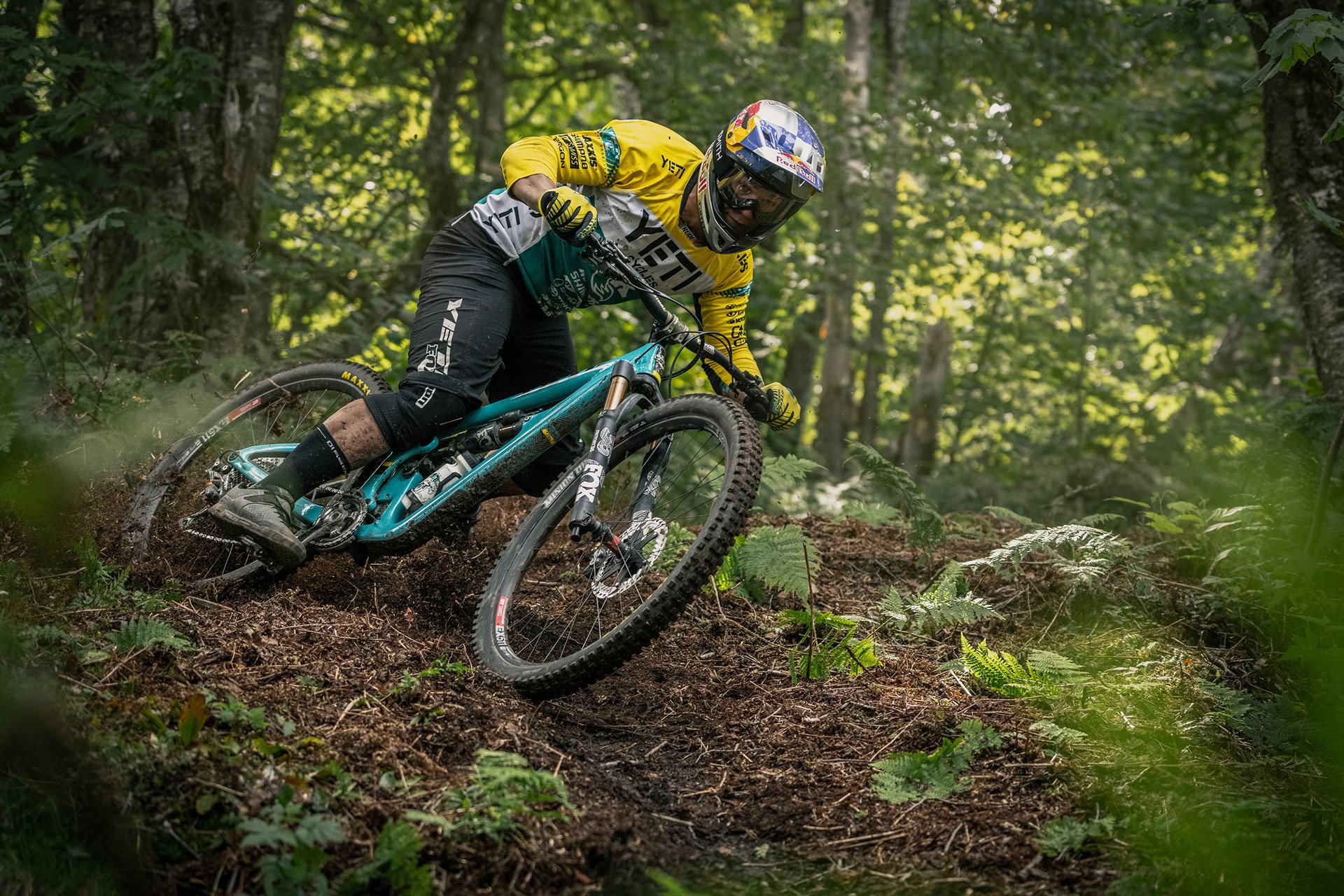
Richie Rude, clean or not, ended 2018 on a tear winning the two final races. In Finale he put 22 seconds into the field. It seems he's getting along with the SB150. Photo - Dave Trumpore/Red Bull Content Pool
CM: Okay. So some of the stuff that's been talked about online - some issues with bushings that were a problem I think on the manufacturing end. How has that evolved since the early launch? I haven't had any issues with my test bike.
PZ: I think one thing to note is that the word issue is kind of strong there and we're talking about the shock bushing correct?
CM: Yup.
PZ: So the one thing there is that the design of those bushings, there needs to be a degree of freedom in order for them to rotate properly. That's designed by Fox. But the thing is that it could happen and it does happen on any brand. It's just that it may not be as noticed on some frames, I think partially as a result of where the shock is located. So for instance our shock is horizontally positioned on the front triangle. People tend to pick the bike up by the shock and so they'll notice some of that play. But that play is actually not detrimental in any way. It's actually designed for that bushing so it works properly. But the perception from a consumer standpoint we've found is that they think that there's an issue with the shaft as a result of some of that play. And so we've gone back and discussed it with Fox and they've changed their tolerance on their side to help with that perception. We've also rolled out that running change. So all new bikes we're selling have that. So it actually isn't an issue from an engineering perspective, but from a consumer perspective it's perceived as an issue.
CM: Gotcha. So similar question with the perception about flex in the swingarm.
PZ: If you do the parking lot test and you take your hand and you hold the saddle and take your other hand and flex the wheel you're gonna get some motion. You get some motion on any bike. And I think the perception is that it's bad. But on the trail we've had no poor feedback about how the bike is riding. It's one of those things that it's not a great loading test for what's happening but what we care about is how the bike is riding on the trail, and some motion or some flex is actually a good thing for tracking and it's one of those funny things that is perceived by the customer and it kind of grows when people read or see what other people are doing but with pretty much any bike you can hold the wheel and push it hard enough to touch the swingarm. But the way the bike performs on the trail is what's important.
CM: I haven't spoken to anyone personally who said they were managing to rub tires on stays but I've heard that anecdotally and we're assuming they've been using the correct size tire. Have you had any reports of that or could it have been a manufacturing thing? What's the skinny on that?
CC: We for sure have heard that and we went back and we asked their shop to look at bikes in their shop and see if it's specific to this model and across the board once they looked they saw that they had tire rub so it isn't an issue for us. It isn't an issue for our consumers. You've had a few people that have been pretty loud about it and I think that's where it's coming from rather than actually being an issue and you can tell us what you think but I, but I think that's a classic case of having some chatter on the Internet and it getting conflated rather than actually having a major issue. We give a broad explanation of what size tire will fit a frame but there's a million variables and that's why we can't give them more information of what will fit. Depending on your wheel size, depending on your tire, they'll be variances on those dimensions so we have to be generally broad about it and we can't give a specific answer.
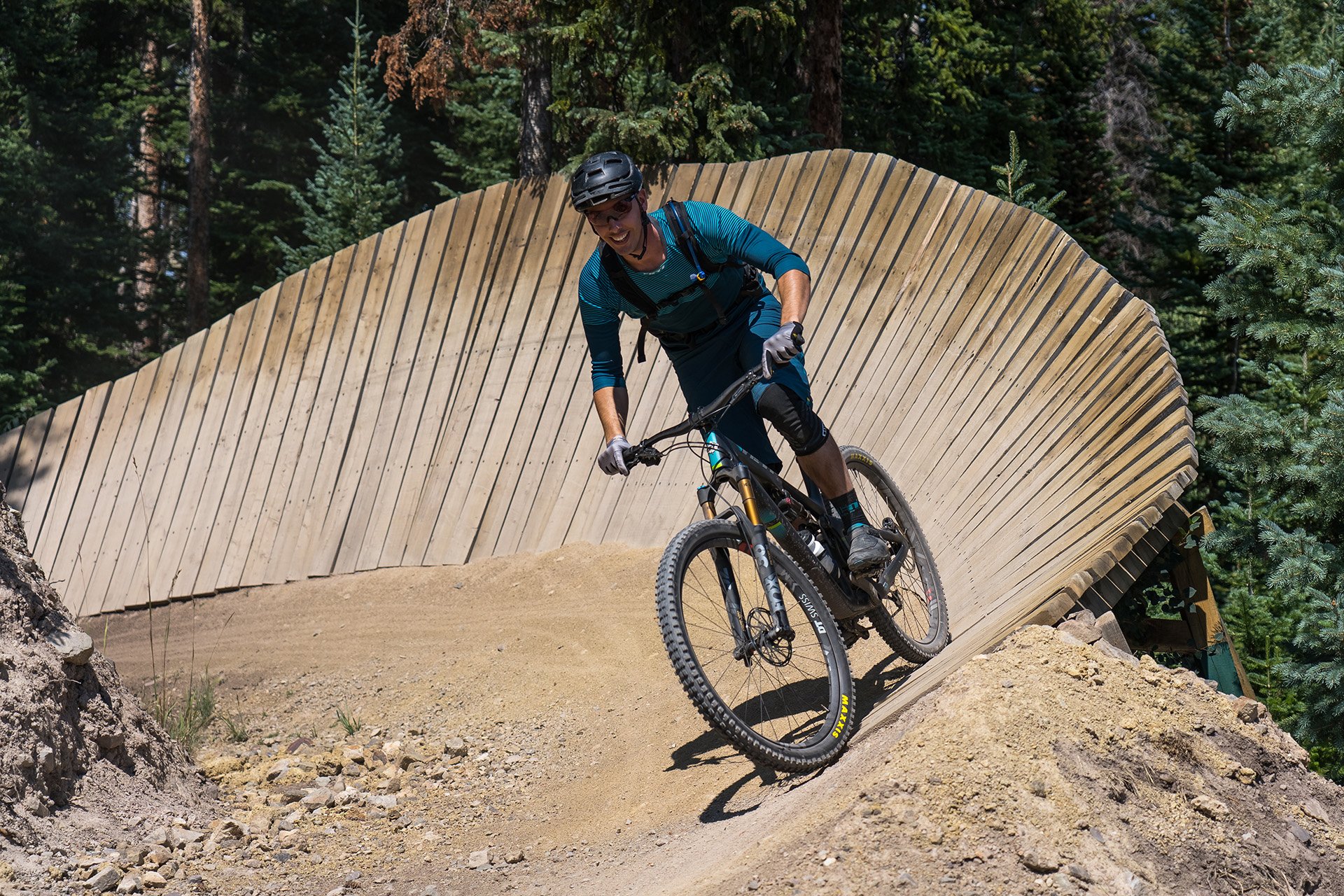
It's surprising Yeti's didn't get longer earlier considering the Director of Engineering is known as Stretch...
CM: A 170mm fork is a little outside the norm since most 29er enduro-type bikes seem to be 160. And Yetis, recently at least, have tended to have 20 millimeters more travel in the front than the rear. What's the philosophy behind that?
CC: There are a few things. One is because of the Switch Infinity we're able to have a suspension system that feels longer travel than it is. As a result, internally when we were doing our testing we were putting longer and longer forks on our test bikes and ultimately what we go to market with is what we all rubber stamp here. The balance of the bike we felt was best, when you consider the steep seat angle and the reach of the bike, so when you're standing, you're centered on the bike and we found it was very balanced with the 170. At the end of the day, they're just numbers. And for us it's all about how the bike rides and whether it's 10 or 20 mils, we're just chasing the best ride and in this case it's 20 mils.
PZ: Yeah, I think that speaks to the quality of our rear suspension. We generally get feedback that the bike rides longer than what the set travel value is in real life. And I think the performance of that travel on that and how you're actually using all your travel and using it properly and then you're also getting the efficiency of that system. So as a result you get a bike that will climb well and will descend with what feels like more travel than there is.
CM: This question might be too big, but I'm wondering about how you balance the compromises of building a bike like the 150 that needs to do so many different things, so well. It can't compromise much climbing and it needs to descend like a downhill bike. How do you balance those opposing goals and figure out where the sweet spot is?
PZ: It all starts with geometry and from there that's our backbone for kinematics and we focus a lot on what's happening there. And we also have a system that allows us to achieve our goals. Obviously we have to start the design with the travel and genre of the bike in mind but it really ends with coming down to what we're achieving on the kinematics side. We don't want to compromise on kinematics or geometry so when the water bottle was part of the equation we had to come up with a solution that would allow us to do that without compromising those. A big part of that is what we've done with our shock extension, where it is in our layout and allowing it to work with the coil and work with air but basically that shock extension is a big portion of that. But we could still put the water bottle, still achieve our kinematics, but we have the space. And then when we're optimizing for our shock extension we wanted to make sure that we wouldn't have any shortcomings there so we have that two piece design that allows us to actually clamp very strongly onto the shock eyelet as opposed to having one piece that you're just relying on some flex of some nature in your extension to achieve that clamping force. And on a lot of shocks out there the width of that eyelet is not something that's standard so it's not highly tolerant as opposed to say the bore of that clamping onto the island on the extension. And then we're also trying to minimize that length so that extension could use a coil shock and not have to worry about any issues there.
CM: Are some of your athletes using a coil shock to start off the year?
PZ: I'm not sure what they'll end up with. They will play around with it and decide what is working best for them whether it's per course...
CC: We're on my iPhone - otherwise I'd look and see what Richie is doing out of his, he's riding down a class right now and I think he's on a coil right now is what I recall that I don't know. Pretty sure. Yeah, look, really frustrated.
PZ: The nice thing is that we feel like we have a good balance on these bikes for the progression of the leverage ratio so they're definitely optimized for an air shock without a doubt. But they're also within a range of progressivity that will work well with a Coil. And so it will give you a lot of flexibility as a rider depending on what you're after.
CM: What about the two of you?
CC: I run the air on mine and you know, maybe because I'm an older guy here and the weight matters to me because I still have to go uphill with these fucking clowns around here that are all 20 something or 30 something. And I'm super pleased with the performance so it hasn't been an issue for me.
PZ: The 130 with a DPX2 is my choice. I prefer the DPX2 for me in terms of the way it feels a little bit more playful. It's terrain based and preference based so it's nice that we have that flexibility
CM: Your preference is going to change if you're going to be spending 8 hours in the saddle at an EWS event.
CC: You're right.
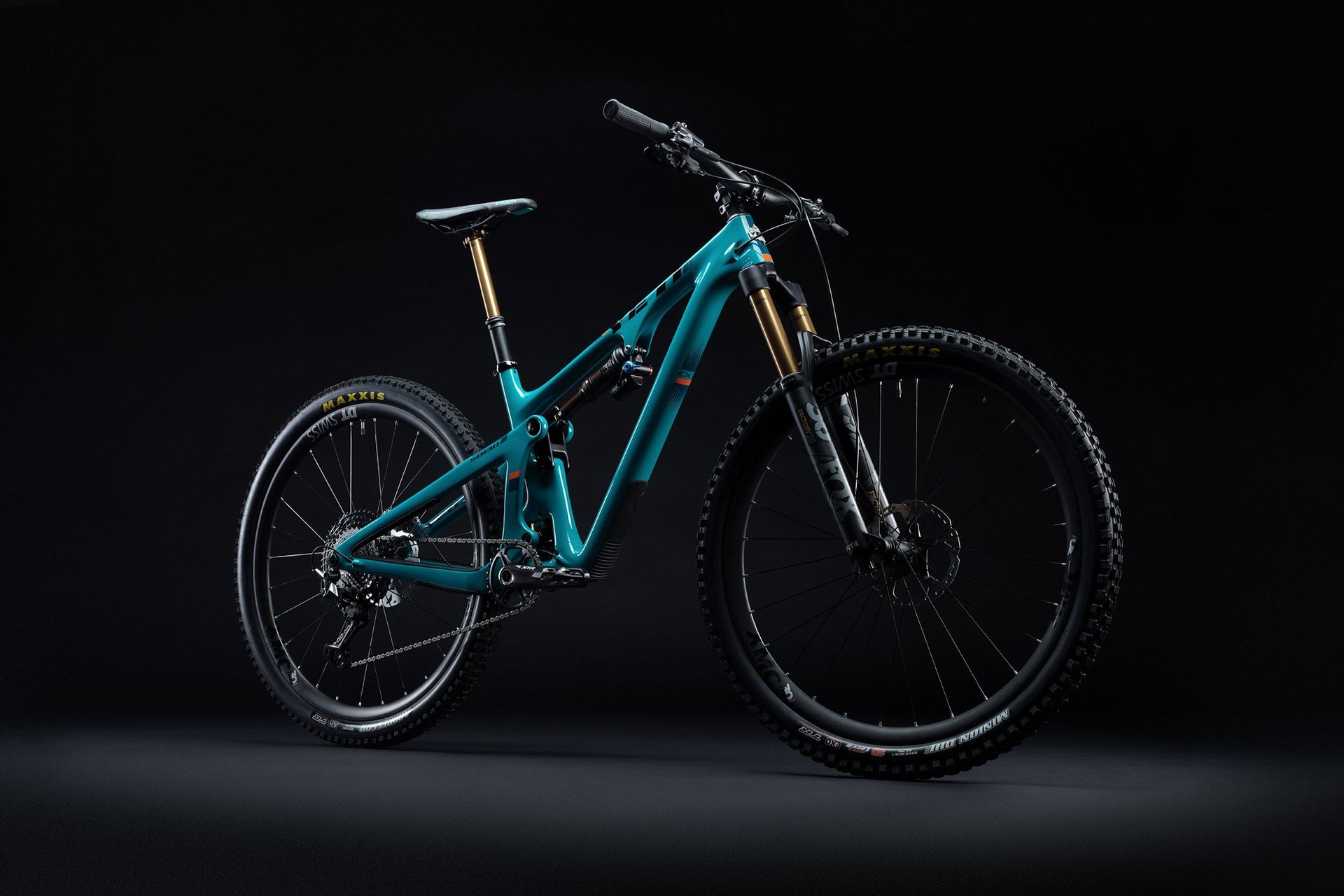
Internally, Yeti employees feel that the SB130 is the direct replacement for the SB5.5 despite having 10mm less travel at each end.
CM: Can we talk a little about the difference between the SB130 and the SB150 and how it relates to the SB5.5 which was right in the middle of the two in terms of travel?
PZ: I think people definitely relate the 150 to the 5.5 in their mind, but really the 130 is going to be much more closely related and 150 is the 5.5 on steroids - for the enduro pro basically - anything up to that level. But I certainly correlate the riding feel of the 5.5 much more closely to the 130 than to the 150.
CC: To give you a little bit of perspective internally the crew around here if they have one bike it's typically the 130 if they have two bikes, that's the 100 and the 150, which is kind of weird. Right? But that kind of gives you the kind of internal psychology and way people internally look at it as well.
CM: Yeah. Obviously I haven't ridden near your office, so I can't talk about the terrain. But most of the terrain I ride with my buddies here is more like you'd see in a downhill course or at least every ride we'll have sections that are really steep and nasty.
CC: My favourite Canadian phrase is 'okay it's really steep here, we're going to roll it and then there's a move at the end.'
PZ: And you're like, 'what the fuck does that mean?'
CM: Haha. Which makes the 150 a great North Shore cross country bike.
CC: Awesome.
CM: Talking about the evolution of geometry, I think like a lot of people, when I got on a bike that was longer... Low and slack, those things I think are pretty obvious. but the longer reach has been quite a revelation for me. And I didn't know something was wrong until I got an a longer bike and all of a sudden the light went on. And and it seems like something that should have been more obvious. It seems like that's such a basic element of the machine and yet it's been a long time coming when maybe it shouldn't have been.
CC: In my mind shorter offset forks are what changed the game. And I think people started experimenting with steeper seat angles as result of trying to make the packaging work with bigger tires and metric shocks and kind of all these other things. You had this kind of convergence of things and we moved the seat angle forward like we did on our 100 just a degree or two and it's like 'wow - this makes a real difference.' And then you lengthen the front end I think you're feeling also in that climbing efficiency the 77 degrees seat angle. That's fucking huge. And I think some of it happened because of fitting different size tires and wheels, all this other stuff. And then we add the short offset and people were experimenting with different things. I think it's kind of a convergence of all those rather than a single thing. Peter has to struggle with this all the time so I'll let him answer that.
PZ: The funny thing is I think Chris answered perfectly. I had some notes that were basically what Chris was saying. But I think part of the evolution was that we were exploring the market in general and you really had to have a super steep seat tube just for tire clearance and testing with that feel and then a longer reach because of that. And then at the same time, you know, people started exploring testing with fork offsets we never had before. Previously though fork offsets were designed match mechanical trail. So as we got 26 and 29, fork manufacturers had to choose an offset to make the most people are happy in a way. And that really was a drive from them but with not a lot of thought I think as to what that offset is actually doing or how it's affecting the rest of the geometry. So as we now had variable offset and we were playing with steeper seattubes I think there was just a natural progression of going to that longer reach. And then feeling like you're riding over the front of the bike a little more. When you're descending your body position is much different but as a result you're much more confident cornering and the stability of what's happening with your slacker head tube and your short offset? I think all those things just as Chris mentioned converged over time. I mean we sort of in a way lucked out, I think in terms of how all those variables stacked up, but I think we're in a good spot now.
CM: So it's funny the way things converge at the same time and lead to a conclusion
CC: I would love to say it's some sort of brilliance we had or someone in the industry had but I honestly think it's just a convergence.
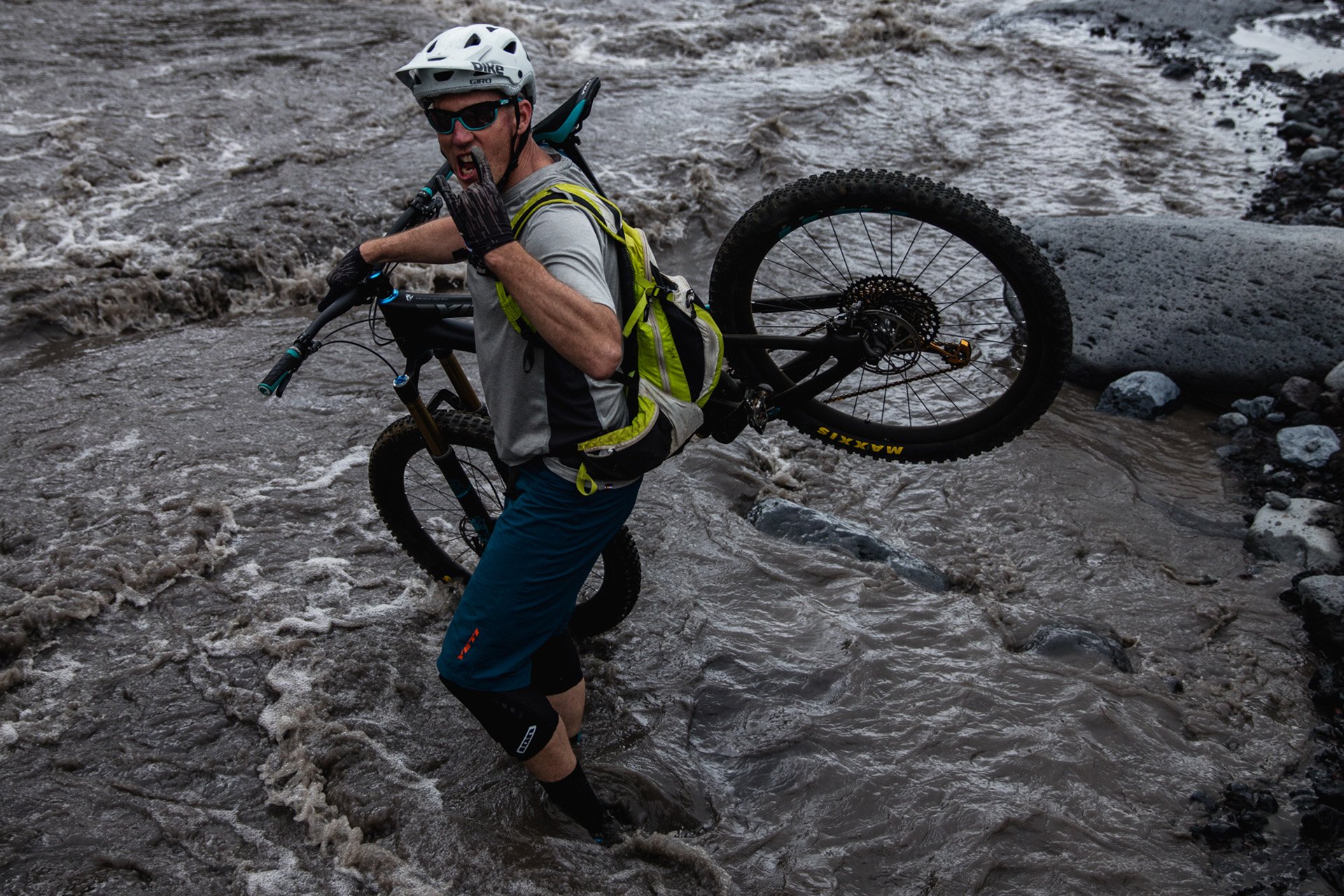
Chris leading the charge at the International Tribe Gathering in Chile.
CM: It makes me wonder about the fact that Fox uses 46 and Rockshox uses 44 when you spend all this time on your geometry. Does 2mm make any difference at all?
PZ: In terms of the value and the effect it has on mechanical trail it certainly does. Which rider can perceive that? You get someone like Richie Rude - I think he could. I think it's one of those things that scales with skill and ability but I definitely think you can tell.
CC: Fortunately we just run Fox right? Without worrying about trying to find the middle ground. We just said, okay, we're running Fox and the offset is 46 and it's designed around that. So it makes it real consistent.
PZ: And if you think about fork offset and the history of fork offset... I don't know this for sure, but I have some thoughts of how that all evolved over time. If you look at fork offset and you look at mechanical trail, and head angle and wheel size. When manufacturers were making forks back when 29 just started appearing, my theory is that they chose their offset so that the head angle would be constant between say 26 inch bike and a 29-inch wheel bike. So from a customer standpoint they look at the head angle and they wouldn't be confused. They'd say "hey, my head angle is the same between these two bikes and they feel comfortable," but it's not necessarily the right way to optimize the system. Now if you actually looked at optimizing the mechanical trail and head angle and offset then you'd have the flexibility to move those variables around how you'd like from a handling perspective and your conclusion is likely going to be different. And I think that's how it's evolving. Back then they chose that value to keep a consistent head tube angle but in reality that might've not been the best choice from a performance standpoint.
CM: Interesting. That's the kind of perspective you would only get from inside the industry. That's an interesting observation.
Okay. Well I think that's, that's it for me. Thanks very much gentlemen!
That was just scratching the surface for me and the Yeti boys; I would have loved to get into racing, Richie's current status, the Tribe... The list is endless. We'll have to save the rest for another time.
Stay tuned for my long term review of the SB150...







Comments
Allen Lloyd
5 years, 1 month ago
Has anybody not in the industry tried riding the same bike back to back with different fork offsets? The idea that a 2mm difference is going to be noticeable just sounds crazy to me. Half the industry people call it the holy grail the other half say it has no impact. I have wanted to try it, but have never had the opportunity to swap forks for a ride.
Reply
[user profile deleted]
5 years, 1 month ago
This comment has been removed.
Niels van Kampenhout
5 years, 1 month ago
FWIW, I unintentionally went from 46 to 42 mm offset on the same (27.5) bike due to an emergency CSU swap on my Pike. I think I did notice a very small difference in steering on the first ride (a bit calmer if that makes sense) but it was not really significant and by the end of that ride my brain had totally adapted to that small change and I can't say it had any lasting impact on my riding.
So I'd say that in isolation it doesn't really matter. But maybe combined with many other small changes in geometry the total sum of those changes can be significant?
Reply
Jason West
5 years, 1 month ago
Your shit is too expensive Yeti. No excuse for that.
Reply
Chad K
5 years, 1 month ago
There was a point in time where I may have agreed with this, but at the current moment, Yeti bikes are no longer exceptionally more expensive than other brands counterparts. The entry price to a Yeti does start higher than many other brands, that I will concede, but the bikes themselves are not exceptionally over-priced like people act like they are.
For example, the Base-model GX Sb130 is $5199. A similarly spec'd Santa Cruz Hightower is $4899 (sans DPX2 shock, which costs more than a DPS), a GX spec'd Ibis Ripmo is $5099, a Specialized Stumpjumper of equal spec comes in a $5000, and a GX Evil comes in at a Whopping $5799.
Reply
Timer
5 years, 1 month ago
While true, it doesn't make the situation any less bad.
I get the willingness to pay a premium for a boutique bike like a Yeti or Unno.
But that kind of money for bread and butter brands like Specialized, Kona, Norco or Scott strikes me as silly.
Reply
Niels van Kampenhout
5 years, 1 month ago
Being expensive is one of the main selling points of a boutique brand 😉
Reply
Cam McRae
5 years, 1 month ago
Indeed that label only comes with a premium price tag.
Reply
pdxkid
5 years, 1 month ago
"We for sure have heard that and we went back and we asked their shop to look at bikes in their shop and see if it's specific to this model and across the board once they looked they saw that they had tire rub so it isn't an issue for us. It isn't an issue for our consumers."
They had tire rub but it isn't an issue for Yeti? It isn't an issue for consumers, yet they had tire rub? I have an SB130 and I'm currently running a 2.3 Maxxis Aggressor that came with the bike, it doesn't rub but many people are reporting rubbing with a 2.5, which Yeti says is ok to run. Yeti admits rubbing but says it's not an issue?
My bike had the bushing knock issue which I fought with Yeti about for over a week before I even rode the bike. They finally agreed to send me the pennies worth of new bushings and no more knock. I like the bike but I don't like The Tribe culture and mentality. I was consistently made to feel like an idiot by everyone at Yeti I spoke with about the bushing issue. I've owned dozens of suspension bikes throughout the ages and the only time I experienced such pronounced bushing play was when they were completely knackered.
Reply
Vik Banerjee
5 years, 1 month ago
They make some nice looking bikes, but I've read too many poor user experiences to spend my own $$ on one.
Reply
bullit398
5 years, 1 month ago
Not really great a great answer on the flex but they won’t admit fault on that even though deep down they have to know they dropped the ball. I have a 150 and it’s an amazing bike. That being said with a 2.4 wt it rubs. Not a lot but enough to see that it happens almost every ride. I don’t feel the flex of the rear is detrimental or excessive. Where they messed up was just not giving more tire clearance. A 2.4/2.5 WT on a 30mm rim is what I would consider the industry standard for this class of bike. It should clear with no issues. I dig the rear ends compliance but if you’re going to build flex in as a feature you should account for it in clearance. There’s probably a good portion of riders on these bikes that don’t push them hard enough to make it rub so the complaints have been few enough for them to just dismiss it. Still it’s a rad bike and aside from that rather minor issue it’s the best bike I’ve ridden.
Reply
disqus_NckwlvD6rR
5 years, 1 month ago
"Fox uses 46 and Rockshox uses 44"?
Am I misunderstanding something? I thought Yeti used a 44 mm offset fork from Fox on these 29ers and Rockshox produces 42 mm offset.
Reply
Tjaard Breeuwer
5 years, 1 month ago
“ And if you think about fork offset and the history of fork offset... I don't know this for sure, but I have some thoughts of how that all evolved over time. If you look at fork offset and you look at mechanical trail, and head angle and wheel size. When manufacturers were making forks back when 29 just started appearing, my theory is that they chose their offset so that the head angle would be constant between say 26 inch bike and a 29-inch wheel bike. So from a customer standpoint they look at the head angle and they wouldn't be confused. They'd say "hey, my head angle is the same between these two bikes and they feel comfortable," but it's not necessarily the right way to optimize the system. Now if you actually looked at optimizing the mechanical trail and head angle and offset then you'd have the flexibility to move those variables around how you'd like from a handling perspective and your conclusion is likely going to be different. And I think that's how it's evolving. Back then they chose that value to keep a consistent head tube angle but in reality that might've not been the best choice from a performance standpoint.”
That’s not true, when 29ers first started appearing, they had the same offset as 26” forks, because that was easy for the fork makers.
As a result, most 29ers either had “sluggish steering” or used steep head angles. People liked the low trail feeling at the time, so that’s what the brands delivered. Using steep head angle, short offset and long chainstays (which 29er had back then) meant weight was extremely front biased, this is bad. So Fisher had tests done, and most test riders preferred the larger offset - slacker headangle combo. So I think, at that time, for those trail figures and riding styles, that WAS the best choice from a performance standpoint.
That doesn’t mean it still is. Now that we have bikes with super slack head angles, wheel flop has become a big issue, as well as wheelbase and front tire loading, so I agree that currently it is good the offsets are being re-evaluated, for performance, just like it was good to have them re-evaluated when 29ers where becoming more common.
Reply
Please log in to leave a comment.